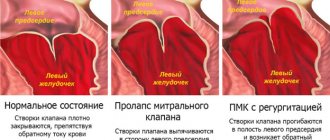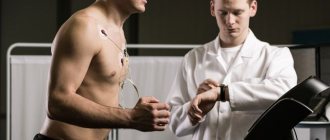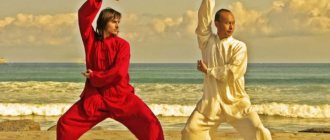But, one way or another, the symptoms of VSD are an unpleasant thing. According to some reports, they poison the lives of up to 80% of people (women suffer from them three times more often than men), imposing certain restrictions, including on fitness activities.
Doctors who recognize vegetative-vascular dystonia distinguish four types of this condition. “And in front of everyone, general strengthening cardio is shown,” says Anastasia Yurkova, fitness manager of the X-Fit “Monarch” and X-Fit “Flotskaya” clubs, personal trainer of the group programs of the federal network of fitness clubs X-Fit. — These are exercises in the heart rate zone no higher than 50-60% of the maximum. At the same time, it is very important to determine exactly your heart rate values; you cannot rely on the “average temperature in the hospital.” For any type of VSD, breathing practices will also be useful.”
Otherwise, fitness recommendations will vary.
Recommendations
With VSD, when going to play sports, you need to remember a few things:
- If you have a mild form of the disease, a good warm-up will not hurt before starting sports. Moreover, it is mandatory when playing sports;
- Don't forget about rest between approaches;
- Thirst is contraindicated for you; take water with you to sports training.
Average form of VSD - exclude sports exercises with lifting heavy loads. Drink water during and between sets. It is best to consult with a professional trainer before sports and trust him to draw up a training program. Let him write an individual sports program taking into account your state of health with VSD.
In severe cases of VSD, it is better to avoid playing sports outside the home and conduct individual training in a gentle manner.
Remember, overexertion during sports can cause a vegetative crisis, which will negatively affect the heart and blood vessels during VSD.
Precautionary measures
Improper physical training worsens the condition of dystonics. Negative consequences may occur:
- sudden attacks of headache;
- discomfort in the heart area;
- severe shortness of breath with a feeling of lack of air;
- irritability;
- sudden mood swings;
- sleep disorder;
- depression;
- depression.
To prevent these conditions, it is better to consult a doctor before starting training and then follow his recommendations.
Training options for VSD
The most useful for vegetative-vascular dystonia are aerobic exercises, water procedures, and massage. Therefore, the most pronounced therapeutic effect is provided by:
- Swimming;
- Running (this includes jogging, running or therapeutic walking over medium distances);
- Bicycle rides;
- Classic aerobics;
- Step aerobics (be sure to exclude strength elements and exercises);
- Morning exercises;
- Morning (or evening) contrast shower;
- Massage.
Exercises in the gym
If your heart belongs to the gym, and you can’t imagine your life without a “rocking chair”, then here are some recommendations regarding exercises on exercise machines or with dumbbells (barbells), which should help you not to aggravate the situation and add a therapeutic effect to sports
The first and most important rule is – don’t chase records, physical activity should be moderate, remember sports in our case – amateur
Prohibited when playing sports in the gym:
- Interval training (aerobic-strength). Instead, you can do strength training with fairly short rest breaks (about 30-60 seconds) and medium to light weights. Remember - our goal is to treat VSD, not overexertion;
- If sports are not an empty phrase for you and you know the following exercises and training systems, then exclude Tabata classes, weightlifting, CrossFit, and any endurance exercises;
- One-, two-, or three-rep sets for maximum strength (at maximum weight);
- Always remember that you need to exercise correctly, avoid bending too much forward when doing squats with a barbell, or holding your breath while doing exercises. The pushing technique is also the enemy of our health and the friend of vegetative vascular dystonia.
What is possible and what is not possible with VSD
With VSD, patients are advised to breathe more fresh air, strengthen their muscles and respiratory system, and improve their nutrition. It is useful to combine walks and rest with exercise, strengthen all muscle groups and the psyche, and tune in to a positive charge.
The main sports recommended for patients with VSD:
- jogging in the morning can eliminate unpleasant signs of illness and maintain physical fitness,
- fitness, step aerobics, but with the platform installed at a low height,
- cycling to develop the muscles of the legs and back, eliminate signs of varicose veins,
- swimming as a gentle method for VSD to train the vestibular system, the pool will also help get rid of extra pounds,
- ice skating to normalize the respiratory system, develop muscles,
- bodybuilding, which people with VSD may prefer,
- fitball with moderate load to strengthen blood vessels.
Exercise machines (bicycle ergometer, treadmill, rowing) are suitable for exercising at home. You can combine exercises, for example: stretching and swimming, or aerobics with strength exercises. The main thing is to prevent signs of arrhythmia and surges in blood pressure. Physical heavy loads during VSD should be carried out correctly and smoothly, starting from 8-12 minutes with a break between exercises of 3-4 minutes.
Is it possible to run with VSD? Running and VSD are quite compatible. The main thing is not to overdo it! Increase the load in the gym smoothly, gradually. It is better to choose complex exercises, combining, for example, aerobics with jogging. It is unacceptable to conduct sports activities through force.
It is good to spend time in nature for those who are intolerant of activities in a confined space, combine physical activity with relaxation, eliminating anxiety and worries. Such walks are well suited for teenagers and young children.
As for contraindicated sports for VSD, these are traumatic, aggressive activities or those that combine increased statistical stress and sudden movements. You should not allow excessive stress or risk your health by resorting to parachute jumping or lifting a heavy barbell. This can cause panic, aggression, psychosis, and deterioration in well-being. In case of VSD, professional weightlifting or powerlifting is unacceptable, even for experienced athletes
Careful choice of occupation for patients with osteochondrosis
Strength wrestling (Greco-Roman, classical, freestyle, mixed martial arts, boxing) is strictly contraindicated. These sports are extreme sports, and sudden movements without respite can lead to increased static tension, dizziness, headaches, and shortness of breath. You must not make sudden climbs, drops from a height, rash jumps, carry heavy objects or sharply raise your legs up, or place your head below chest level. This will lead to severe stress on the muscles and heart, which is simply unacceptable with VSD.
Contraindicated:
- resort to strength exercises,
- conduct weightlifting classes,
- test the body for endurance, strength,
- hold breath,
- do sudden squats and bends forward,
- train with a barbell.
Useful exercises
To stabilize the well-being of a person with vegetative-vascular dystonia, exercises are selected that smoothly activate all systems in the body. Will benefit:
- running, walking, exercising on a treadmill;
- riding a bicycle or exercise bike;
- step aerobics;
- swimming or water aerobics;
- morning exercises;
- badminton, volleyball.
These sports eliminate sudden loads, as well as rapid changes in body position in space with the impact of significant overloads. At the same time, the vestibular apparatus, balance, and coordination of movements are trained. In addition, physical activity involves rhythmic breathing, which improves oxygen circulation.
Under the influence of physical activity, the functioning of the cardiovascular and nervous systems improves, and the severity of symptoms of vegetative-vascular dystonia decreases.
What do doctors advise for VSD?
The main thing is that the classes bring joy, pleasure, a relaxing and preventive effect. They should help, not aggravate the condition. Exercises should be aimed at:
- establishing proper breathing,
- regulation of the sequence of inhalation and exhalation,
- involvement of the abdominal muscles and diaphragm in the respiratory process.
Make all movements smoothly. So, for example, if you don’t have a simulator at hand, you can resort to doing exercises at home:
- stand up, taking the starting position, perform circular movements with your arms in different directions,
- cross your hands in your palms, pressing on each other, and so on for up to 15 seconds,
- tilt your head forward, tilt it to the right, then to the left, repeat the exercise 5-6 times,
- straighten your arms at your sides, clench them into fists, make sweeping movements up and down for 1 minute,
- lower your arms down, place your feet shoulder-width apart, extend one arm forward and raise it up, take the other back and raise the top, exhale slowly, lower your arms, do the exercise 6-7 times,
- put your hands on your shoulders, perform circular movements with your shoulders, slightly turning your body alternately to the right and left,
- extend your left arm, move it back and to the right, extend your right arm and move it to the left, repeat the exercise up to 7 times,
- take a standing position, bend your left leg at the knee and move it to the side, make springy movements using stretching exercises, repeat with the other leg,
- put your hands on your belt, bend your right leg at the knee and lift it up, hold for 3-4 seconds, repeat the movement with the other leg, and so on 7 times.
An insidious disease - vegetative-vascular dystonia, is it possible to play sports - doctors do not give a definite answer. It’s bad if a person constantly experiences stress, depression, excessive anxiety and fatigue
You shouldn’t joke with dystonia, and when choosing a sport, consider indications and contraindications; the degree of progression of the disease is extremely important
A set of exercises recommended for VSD is presented in the video:
General recommendations for athletes with VSD
To ensure that physical activity does not become a cause of deterioration in well-being for patients with VSD, the attending physician, as a rule, gives recommendations. Their implementation will allow you to exercise profitably and eliminate exacerbation of the underlying or concomitant diseases:
- do not perform exercises in which the head should fall below the chest;
- Deadlifts are not allowed, especially in cases of severe circulatory insufficiency;
- the body should not be allowed to overheat;
- If you feel unwell, you must stop training for several days;
- all power loads must be interrupted for a few minutes to rest;
- work with maximum weight is completely eliminated;
- It is not recommended to hold your breath for a long time;
- Experienced doctors do not advise working out in the gym alone.
Once diagnosed, physical activity is generally recommended. If the patient has not been involved in sports before, he will have to reconsider his attitude and begin to lead a healthy lifestyle, which is impossible without performing feasible physical exercises
It is important that the start of classes occurs quite smoothly. To begin with, you can make it a rule to take a walk in the fresh air before bed, and then move on to more intense exercise.
Additional nuances
The following will help increase the effectiveness of physical exercise in patients with VSD:
- deep, rhythmic breathing during training;
- complete, balanced nutrition;
- contrast shower: the procedure stabilizes the functioning of the cardiovascular system.
Physical exercise is an excellent adjuvant method for treating VSD. The main thing is to approach this issue correctly. For example, even with severe dystonia, there are options for physical activity that ease the course of the disease by distracting the patient. This is billiards:
- when a person plays a game of billiards, he calms down and concentrates;
- the sight of green cloth relaxes the eyes;
- leisurely walking around the table sometimes lasts several kilometers, especially when playing a long game, for example, “Russian pyramid”;
- the poses that a player takes to play this or that ball train stretching;
- eye training allows you to forget about panic attacks.
The main thing is that playing billiards is not accompanied by smoking tobacco and drinking strong alcoholic beverages, as is often the case in male groups.
Recommended types of exercise
When making a diagnosis related to dysfunction of the autonomic system, you need to start every day with physical activity. Immediately after waking up, you need to perform several correctly selected exercises aimed at:
- to strengthen the heart and blood vessels;
- to work with breathing;
- to develop coordination;
- to improve muscle stretching.
Each exercise must be performed slowly, without unnecessary effort, trying to feel muscle pleasure. For concomitant diseases, a set of exercises is selected taking into account not to cause harm. If you have symptoms of cardiovascular diseases such as high or low blood pressure, you must exclude:
- sudden movements;
- increased cardio loads that make you short of breath;
- jumping and shaking, etc.
General recommendations
If the vegetative-vascular system is disordered, you can choose different sports, with the exception of those that cause a heartbeat above normal, shocks and concussions. This could be: Nordic walking, swimming, gentle jogging, cross-country skiing. Training should be regular and moderate. But with VSD, physical therapy (physical therapy) must be included in the adaptation course. The advantages of this type of physical activity are that they:
- performed from a standing or lying position;
- aimed at all muscle groups;
- train breathing and develop coordination and flexibility.
Physical therapy for VSD should be performed regularly. It is better to exercise in the morning, an hour after a light breakfast, an hour before a second breakfast or snack. Exercises should be selected in such a way that strength loads, stretching and relaxation movements alternate. They should be performed slowly, until you feel slightly tired, excluding overwork.
Gym
Click to enlarge
For those diagnosed with VSD, moderate and quiet exercise in the gym is useful, but only in cases where there is a tendency to hypotension: if you have high blood pressure, you cannot exercise on exercise machines.
When putting together a complex using simulators, you must definitely select exercises to improve or correct your posture. Most often, VSD develops in people with poorly developed back muscles. The condition of the spine causes incorrect position of the internal organs, their normal blood supply and function deteriorate. All this aggravates the condition of the patient, who definitely needs to strengthen his back.
Exercises for VSD at home
For a person with dystonia, it is not enough to work out with a mentor in the gym: it is necessary to master the complex for independent exercise: all exercises are useful for VSD: gymnastics in the morning, physical therapy, just stretching. At home during the day you can perform the following exercises at a calm pace:
- for breathing - training the diaphragmatic type;
- from a supine position - for the abdominals;
- lying on your stomach - to strengthen your back muscles;
- standing - for balance and coordination.
Swimming with VSD
Swimming for vegetative-vascular disorders is necessary. This is one of the most gentle and at the same time effective sports. The main goal of water exercises is to develop general endurance and at the same time normalize the functioning of the central nervous system. Calm swimming, without racing for distance and speed, will bring benefits.
Correct breathing
When performing any physical exercise during VDS, you need to take into account the patterns of the influence of breathing on the vegetative-vascular system. Competent control of your own breathing will help you tolerate the load well and perform exercises effectively. The following algorithm is required:
Inhale through the nose. After we take a deep breath, we try to visualize how the air fills all our lungs, and as we exhale we perform the exercise. Exhale through the mouth, allowing the air to come out freely and completely. It is important to breathe correctly and perform all movements measuredly and accurately: in this case there will be no loss of strength, and the patient will feel muscle pleasure.
Effect of physical activity
Physical education has a beneficial effect on the human body. Regular exercise stabilizes the functioning of the cardiovascular system. Blood microcirculation improves, the functioning of the nervous system and internal organs is normalized. This is important when there is a lack of physical activity or an office work pattern, which is found in urban environments.
However, many exercises require too much work. They can provoke increased symptoms of vegetative-vascular dystonia. Therefore, when planning physical education classes, a preliminary consultation with a doctor or trainer is required.
Where to start running as a VSD student
With self-acceptance! Only when you understand that running is the only true and even exclusive means of combating your illness, can you start training without fear. If you just decide to try it and then stop, don't start: running loves to be spoken to respectfully!
Start with 2-3 minutes, adding 1-2 minutes each workout. And when the running duration reaches 15 minutes, you need to move on to classes strictly every other day, continuing to add 1-2 minutes to each session.
40-60 minutes of running strictly every other day is the optimal norm for an adult, regardless of gender. An integral part of training is... SELF-CONTROL, with which you must always be very correct.
Beginners need to keep a self-monitoring diary, where they record their “pros” and “cons,” as well as the quality of sleep, heart rate and blood pressure before and after training.
We will talk in detail about self-control separately, but now I’ll just remind you that an hour after jogging, your pulse should be no more than 10-12 beats compared to the initial data. For example, before running the pulse was 70 beats/min, and after running it was 82. That means good!
VSD refers to pathological signs associated with impaired functioning of autonomic reactions. Their list can be very extensive. We list the most common ones found in the clinic:
- headache;
- fluctuations in blood pressure and temperature;
- emotional lability;
- excessive sweating (hyperhidrosis);
- periodic and reversible sensitivity disorders (paresthesia);
- chilliness, or periodic feeling of heat;
- redness or paleness of the skin;
- panic attacks, or “vegetative storms”, which are accompanied by the fear of death.
Sport with such symptoms is a controversial issue.
- Some doctors try to convince patients that physical activity is undesirable for them and can aggravate the condition.
- But there are exercises to normalize the functioning of blood vessels. Therefore, VSD and sport are often interconnected. And in the end, life is movement. And for functional disorders, it is quite possible to choose the right exercises that will not cause unpleasant symptoms.
Sport is an auxiliary method of treating VSD, which increases the effectiveness of therapy. Before selecting a set of exercises, remember these simple recommendations:
- Physical activity should increase motor activity, but not cause sudden changes in body position.
- Don't train as hard as you can. Overload is fraught with deterioration in health.
- Constant monitoring of pulse and blood pressure after another workout causes unnecessary anxiety, which leads to an exacerbation of symptoms.
- Exercise in comfortable clothes and preferably in the fresh air.
- Combine different types of loads to activate all muscle groups.
Sports activities accompanied by your favorite music increase the productivity of your workout and improve your well-being.
In case of vegetative-vascular dystonia, vigorous sports are not recommended. Constant competition, anxiety and fear of losing provoke an exacerbation of the disease.
It is better to limit yourself to simple physical education. In this case, it will be possible to normalize the state of the cardiovascular and other systems while maintaining good health.
Home exercises
Doctors recommend that people with VSD perform a set of simple exercises at home every morning, not forgetting about proper breathing. The most accessible workouts are: simple lunges with your feet forward, bending and turning your torso to the sides, alternately raising your legs to waist level, circular movements of your head, stretching and gentle twisting in a sitting position, and breathing exercises.
These simple exercises harmonize metabolic processes and improve a person’s well-being.
Boxing and VSD
Boxing, like most other martial arts, is one of the extremely undesirable sports for people with VSD. After all, it involves hard contact with the opponent and striking the body. Such an effect has a negative impact on the patient’s condition and worsens well-being.
Boxing itself is a harmful sport, since it is allowed to bring a person to the point of blackout with blows to the head. And, despite the fact that upon reaching this state, a technical knockout is counted and the fight is stopped, the consequences of the injuries received can be very serious. Let us remember the great Mohammed Ali, whose lot was severe parkinsonism.
In the same case, if the sport is selected taking into account the patient’s complaints, and physical activity brings pleasure, vegetative-vascular dystonia gradually recedes, and the body’s adaptive capabilities increase. With regular exercise, a person can significantly improve their well-being, and even forget about the symptoms of VSD forever.
Vegetovascular dystonia is a disease characterized by damage to the autonomic nervous system (ANS), which is responsible for the normal functioning of all human internal organs. Hence, patients often have a reasonable question: is it possible to play sports with VSD? To answer this, you need to see a doctor - he will determine the specific form of the disease and select the permissible load.
VSD is manifested by a complex of symptoms that significantly worsen the patient’s well-being
There are several forms of VSD - hypo- and hypertensive, cardiac, asthenic, respiratory, tachycardial, visceral and mixed. For each of them there are specific restrictions on the intensity and type of load. However, VSD and sports are quite compatible, and if the load is adequate to the patient’s condition, it will only benefit him.
Contraindications and prohibited types of loads for VSD
Without physical activity it is impossible to treat VSD. But in some conditions, unnecessary physical effort should still be avoided. Contraindications to exercise are:
- pain syndrome of any etiology;
- elevated temperature;
- high blood pressure;
- dizziness and migraine.
Click to enlarge
If doctors have found vascular dystonia (VSD) in a child or teenager, exemption from physical education should always be at hand. An exacerbation of the disease can begin at any time, so it is necessary to inform teachers about the diagnosis of VSD. It is also necessary to explain to them that even with such minor ailments as a slight headache or dizziness, any, including gentle physical exercise, is strictly prohibited.
During the period of remission, doctors recommend that such patients resume exercise gradually. If you feel normal, then you still need to avoid traumatic sports, as well as activities of this kind, when the patient may experience stress, excessive nervous tension or fear.
Extreme sports such as skydiving or diving are prohibited. You should not get involved in tennis, weightlifting, long running over long distances, or participate in sprint competitions, which also force you to strain yourself to the limit of your physical capabilities. You should not compete in boxing, sambo, karate and other types of wrestling.
Is it possible to play sports with VSD?
Children's sport is about practicing movement techniques, developing motor skills and functional training. In parallel with muscle training, the child’s body develops the ability to breathe deeply and rhythmically, optimally distribute oxygen and energy between “working” and “resting” organs, and dose the volume of blood ejected by the heart per unit of time. The walls of blood vessels gradually adapt to the growing load, become more elastic, and their tone and capacity increase.
You don’t become an athlete in a week; gradualism, systematicity and consistency are the main principles of training. By the time maximum results are achieved, the child’s body will be functionally ready, and, most likely, completely healthy. Therefore, if a child has obvious inclinations and, most importantly, a desire to play sports, and the coach has been warned about the symptoms of VSD, there are no contraindications.
Choosing a direction
Is it possible to play sports with VSD? Of course, you just need to choose a direction that is safe for the patient. There are different types of physical activities, but not all of them are suitable for VSD.
In athletics, you can use all directions, except for putting weights: shot, hammer, discus, and it is also necessary to exclude pole vaulting. Running will be the best and unique thing for the whole body. When running, more than 80% of the body's muscles are used, all body systems are included in the work, supplying oxygen to all internal organs. For effective training, you need to gradually raise the bar and increase the load, create a regular schedule and follow all the rules. The heart will gradually start working, coping with a large volume of blood, so the person will no longer feel pain in the heart area and disturbing thoughts will not visit him. The brain will feel much better, since excess oxygen and increased blood supply will speed up thought processes, help get rid of depression and cope with stress more easily.
Cycling and horse riding also have no warnings for VSD; the main thing here is smooth movements without jerks and a measured rhythm. In winter, these activities can be replaced by skiing or skating.
There are restrictions for martial arts; these game sports can only be allowed without participation in sparring and, especially, competitions. One can learn this art from a technical point of view. The same applies to acrobatics, gymnastics and figure skating, because they are quite traumatic and can cause irreparable harm, especially with brain injuries. Alternatively, you can use aerobics or fitness classes. It is these directions that will help bring the body into ideal shape, give strength to the body and give yourself a good mood, resisting stress.
You can use water aerobics or swimming for VSD. Exercises in water relieve stress from the spine and joints, strengthen the cardiac system and respiratory organs.
To strengthen the vestibular system, you can try exercises on a fitball, just remember to measure the exercises. With this item it is convenient to do stretching, which is beneficial for any body.
In summer, in good weather, you can have fun with football, volleyball, tennis, and badminton. These games, in addition to providing a positive charge, will help improve your health.
Vegetative-vascular dystonia is a problem that does not tolerate inaction. You need to take your health seriously and reconsider your current lifestyle. Start moving more, engage in safe exercise, and start eating well. Then you will not be afraid of any neuroses or mental disorders.
The main cause of neurosis and panic attacks is vegetative-vascular dystonia. Everyone has heard at least a glimpse, but who is familiar in detail with the nature of this disorder, its symptoms? Dystonia itself is not a disease, but only a consequence of disruption of the heart and cardiovascular system. Scientifically, this is called a polyetiological syndrome or symptom complex. VSD is classified into four different symptom areas:
- mixed type
- hypotonic type
- hypertensive type
- cardiac type
In addition to classification by type, vegetative-vascular dystonia is divided into degrees, severity, and frequency of symptoms. There are 4 degrees in total, with the 4th being the heaviest. VSD of any type and severity is not dangerous, but it makes life, sports, and bodybuilding very difficult. The article will discuss in detail how you can successfully avoid misconceptions and problems associated with playing sports with VSD syndrome.
Similar on the site:
Harmful exercises
Physical activity and sports that are contraindicated for patients with VSD : martial arts (karate, boxing and others), high or long jumps, discus or shot throwing, powerlifting, kettlebell lifting, weight training and some others.
Such training is excessive stress for the body, which can cause an attack of severe headache, shortness of breath, stabbing pain in the heart, and other manifestations of VSD. They can be practiced not just by healthy people, but by those who have significant body reserves and adaptation to heavy loads.









